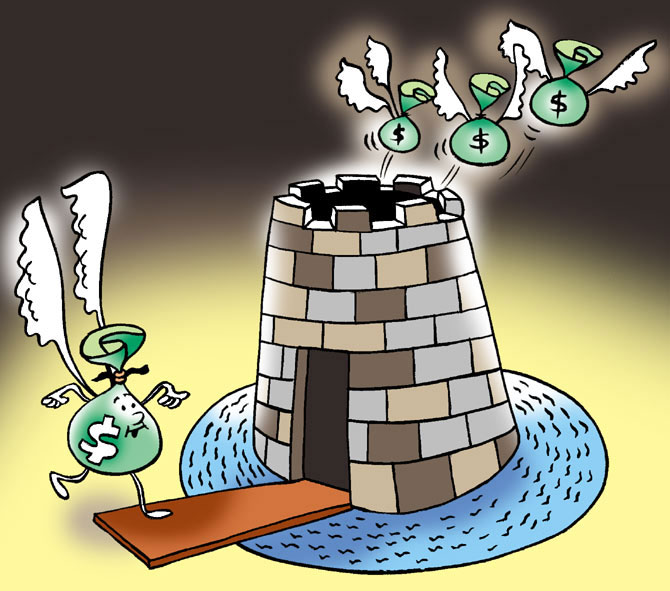
High current account deficit means that a country is buying more from outside than it can afford to.
CAD, CAD, CAD … the most repeated ‘word’ in the financial world, today. India’s economy is in a mess – blame CAD; inflation is spiralling out of control – blame CAD; rupee is sinking – again blame CAD (recently a pink paper while discussing rupee woes, wrote, ‘the undercurrent of an unsustainable and rigid CAD on rupee is a common knowledge’).
So what is CAD, and why is it so dangerous? Can the government control CAD? Read on to know all bout current account deficit.
What is Current Account Deficit
A current account simply is an account of all money that comes into the country (as receipts for exports of goods and services, investment income or as capital) and all money that goes out of the country (as payments made for importing goods and services, paying out income for investments made by foreign entities in the form of interest or dividend, or outflow of capital from the country).
When the outflows are more than the inflows, a deficit occurs in the current account of the nation, which is widely known as the Current Account Deficit (CAD).
The CAD of India was $87.8 billion during Financial Year 2012-13. How was this figure arrived at?
Click on NEXT to know the answer...

The composition of CAD
India exported goods worth $306.6 billion during the financial year. The exported goods included textiles, gems and jewellery, mineral fuels, etc. On the other hand, it imported goods worth $502.2 billion, half of it on account of gold and fuel. This is the reason there is so much stress on reducing the oil and gold import bills by the Reserve Bank of India and the Ministry of Finance.
The falling rupee is not helping matters as it makes the import of fuel and gold more expensive in Rupee terms.
India also exported services worth $145.7 billion and imported services to the tune of $80.8 billion during the financial year. There was a net surplus. The surplus can be increased by increasing exports further or by decreasing the import of services further.
The falling exchange rates might help the exporters increase their market share by offering discounts. When the rupee falls, the exporters get more Rupees for every dollar. Hence their revenues in Rupees goes up. Similarly, import of services become more expensive.
Inflows due to other forms of income like transfer of money by Non-Resident Indians and investment income received, amounted to $78 billion while the outflows amounted to $35 billion.
Total inflows minus the total outflows amounted to a CAD of $87.8 billion (Table 1), forming 4.8 per cent on our Gross Domestic Product (GDP).
Composition of the Current Account Deficit (in $billions) | |||
| FY 2012-2013 | ||
| Credit (Inflows) | Debit (Outflows) | Net |
Goods | 306.6 | 502.2 | -195.6 |
Services | 145.7 | 80.8 | 64.9 |
Primary and Secondary Income | 78 | 35 | 43 |
Current Account Deficit |
|
| -87.7 |
Source: RBI | |||
Click on NEXT to read why we should worry about a high CAD...

Why should we worry about a high CAD?
High CAD means that a country is buying more from outside than it can afford to. The consequence of this may not be felt too much in the short term. But in the long term, the domestic currency can start to lose value as payments in dollars far exceed the amount of dollars that the country receives.
The demand for dollar goes up, making its value appreciate, which in other words means that the domestic currency loses value. This is what we are experiencing in India right now.
If the domestic currency loses value, the foreign investors lose interest in the economy of the country as the returns may not be adequate to them when they convert back the rupees to dollars.
For example, if an investor invests $100 in India when the exchange rate is Rs50 per dollar, he buys assets worth Rs 5,000 in India. After one year, the value of the asset is Rs 6,000. The appreciation in value is 20 per cent.
The investor wants to sell off the asset and take back his money to the US. So he sells his assets and gets Rs 6,000. When he goes to convert the rupees back to US dollars, the exchange rate being quoted by the bank is Rs 62 per dollar. So the investor get $96.8 in exchange for Rs 6,000.
The investor has actually lost money. He has lost 3.2 per cent on his initial investment of $100.
This explains why, in the long term, investors would shy away from a country with depreciating currency, which is one of the consequences of a high CAD.
Click on NEXT for more...

Measures to control CAD
In order to control the CAD, the government would put in place various restrictions on the import of non-essential goods to start with.
As in the case of India, finance minister P Chidambaram recently announced a curb on the import of gold coins and medallions.
Other measures like making it easier for foreigners to invest in India, making it easier for companies to raise money outside India (this brings in foreign exchange, though interest needs to be paid on it) were also announced by the finance minister.
If these steps do not reduce the CAD, further measures could be more restricting or severe in nature.
Nupur Pavan Bang is Senior Researcher, Centre for Investment, Indian School of Business, Hyderabad. She can be reached at Nupur_bang@isb.edu